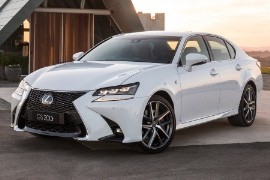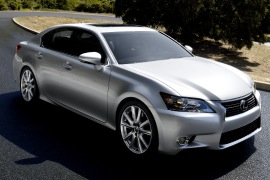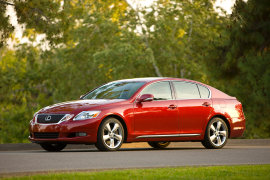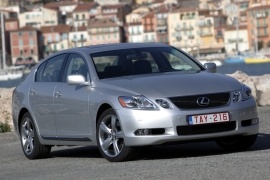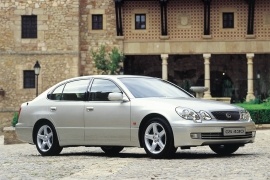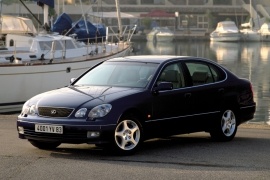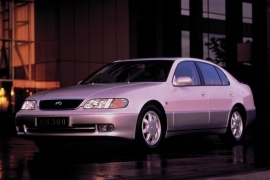LEXUS GS Models/Series Timeline, Specifications & Photos
First production year: 1993
Engines: Gasoline, Hybrid, Hybrid gasoline
Lexus introduced the fourth generation of the GS in 2011 and refreshed it in 2012 with a proper facelift that focused mainly on the exterior and the engine bay.
Creating a luxurious mid-size sedan was already something that Lexus knew how to do. After three generations of the GS nameplate, it learned what its customers wanted and complied. But there was one area that it hadn't mastered completely, and that was how to facelift a model that was already good. With the 2016 model year of the GS, the automaker proved that it learned that lesson well, and the new version looked like a completely different vehicle. Even though it relied on the same underpinnings as its non-facelifted brother, the refreshed version of Lexus's mid-size sedan was longer, provided a roomier cabin, and was powered by new engines.
Lexus adopted a new design language for its entire lineup and adjusted the look of the GS accordingly. As a result, the 2016 model year came with a tall spindle grille stretched from the hood to the lowest part of the apron. This was flanked on the upper side by new headlights sporting three LED blocks and on the lower side by a set of scoops that housed the LED fog lamps. The same light-emitting diode technology was used for the arrow-shaped daytime running lights that pointed toward the brand's badge that took center stage on the prominent grille.
From its profile, the clean-looking bodywork featured curved panels for the doors and fenders, with enlarged wheel arches that covered the standard 17-inch alloy wheels. Lexus also offered customers the option to get a 19-inch set, which was standard for the F-Sport package. The increased front and rear overhangs led to a longer overall length of 1.2 inches (30 cm) but featured the same wheelbase. At the back, the angular-shaped taillights extended from the quarter panels to the trunk's lid were also new and, like the headlights, were based on LEDs. Underneath the bumper, the automaker added a new valance flanked by flat, angular-shaped exhausts.
Inside, customers were greeted by an enhanced cabin. They could choose either if they wanted wood or aluminum trims, depending on their tastes. In addition, the automaker offered the option for piano-black decorations that adorned the center console, the dashboard, and the door cards, depending on the market. Regardless of these finishes, the 2016 Lexus GS came fitted with the same 12.3-inch LCD placed atop the center stack, neatly integrated into the dashboard, for the infotainment system. Lexus was the only car manufacturer in the premium segment that offered a mouse-like controller, while most other automakers preferred a rotary dial. This differentiated them, but customers were not very fond of the system. For an excellent sound experience, the GS was available with a 17-speaker Mark Levinson audio system. The Japanese premium car manufacturer used man-made leather for the GS's interior and installed heated and ventilated front seats and available heated outboard seats.
Under the hood, most engines were carried over from the non-facelifted version of the car, but there was also a fresh turbocharged inline-four gasoline unit. This helped the automaker lower the starting price of the car while still providing enough performance for its mid-size sedan. Besides the hybrid versions, all gasoline-only powered ones sent their power to the rear or in all corners via an eight-speed automatic transmission.
The fourth generation of the GS mid-size sedan premium was unveiled at a special event during 2011's Pebble Beach Concours d'Elegance, surprising everyone with its bold new look.
Toyota's premium brand, Lexus, worked hard to convince premium buyers that the GS was worthy. It succeeded because all generations of this nameplate boasted some of the highest rankings in the automotive industry. Furthermore, the luxurious cabins and comfortable rides were also part of the package, which finally made buyers think twice before spending their money on European or American luxury brands. But there was only one problem with these cars; they weren't exciting. Even though on paper they looked sporty, especially for some versions, they were just quick in a straight line but didn't provide any sort of thrill on a winding road. But everything changed with the fourth generation of the GS. Furthermore, it was also available in an F-Sport trim, which enhanced the car's look, making it more aggressive. As for the drivetrains, it had something for every taste.
While its predecessors tried to attract the public's attention with their unique four-headlight styling, the fourth generation of the Lexus GS rolled back the styling time. It went straight to the first generation of this moniker penned by Giugiaro, offering a pair of horizontal ones. They also sported a pearl-like line of L-shaped LEDs for the daytime running lights. As a result, it looked more traditional, albeit with a prominent front fascia that sported the spindle-grille design language. The lower side of the bumper featured an apron that had a rectangular center air intake flanked by the scoops that housed the available fog lamps.
With a profile that looked more like a regular sedan than a hatchback, like its predecessor, the 2013 Lexus GS had a sporty appearance. The ascending waistline started from the front wheel arches and went to the taillights. In addition, even base models featured aerodynamically profiled side sills. In standard trim, the GS came fitted with a set of 17-inch alloy wheels, while the options list included other sets two inches wider in diameter. In 2012, most premium automakers offered turn signals integrated into the door mirror caps, and so did the GS. Another significant design change was for the C-post, which sported a more angular shape in its mid-section, not curved like on the previous generations of the car. At the back, depending on the grade and engine version, the automaker installed broad taillights that emerged from the quarter panels onto the trunk lid. As an option, the car could be fitted with a lip spoiler on the trunk.
Inside, there were acres of leather on the door cards, seats, dashboard, and armrests. Fronting the driver was an instrument cluster that featured two large dials for the speedometer and the tachometer that flanked a small-size TFT monochrome display. Above the center stack, Lexus installed a 12.3-inch screen for the infotainment system. Drivers could control it via a mouse-like controller housed by the center console. The front seats provided mild side bolstering, while in the back was enough room for three adults, although the tall transmission tunnel made the car more suitable for two occupants.
Under the hood, the 2013 Lexus GS offered a choice of gasoline or hybrid drivetrains, all paired with a six-speed automatic or eCVT transmission. The top-spec version was the 460, which provided plenty of power and grunt to keep up with the best in business.
Lexus refreshed the GS lineup in 2007, just two years after it unveiled the model’s third generation at the 2005 North American Auto Show, and the facelifted version came with significant improvements.
When Lexus started to work on the facelifted version of the GS’s third generation, it didn’t know that a world financial crisis was about to begin. But still, that didn’t stop the automaker on its tracks to create one of the most fuel-efficient performance sedans on the market, which was the GS450h. Those who preferred a more classic approach could take the fresh 4.6-liter V8 version or the other available two V6 powerplants. However, Lexus had already learned how to do a facelift and applied its knowledge to the refreshed model. Besides the improved or new technologies integrated into the vehicle, it also added more safety systems that kept its occupants safe.
The car’s front was redesigned and featured new, sharper-looking swept-back headlights. They flanked a redesigned grille that sported horizontal slats supporting the brand’s badge in the middle. Depending on the grade and options, there were thicker or slimmer chromed accents on the front fascia, adorning the headlights and the grille. At the same time, the lower bumper was also new and had a trapezoidal center-mounted air intake instead of the rectangular one from the 2006 model year. The car’s side scoops could house the fog lamps.
From its profile, the most significant difference was the introduction of the turn signal lamps into the door mirror caps. But still, the elegant and sporty look of the GS remained largely untouched. Behind the short deck, depending on the grade, the car had a new lip spoiler that adorned the trunk’s lid. Lexus also added new designs for the 17-inch alloy wheels fitted as standard on the lower grade versions, while the GS460 rode on 18-inch ones. At the same time, the taillights were new, featuring LEDs instead of halogen light bulbs and a new design with circular patterns on the lenses.
Inside, customers were transported comfortably by the ten-way power-adjustable front seats, with an option for bolstered ones that provided more side support during high-speed cornering situations. Lexus also improved the sat-nav infotainment unit, which was available with a 14-speaker Mark Levinson system on par with the ones provided by the Mercedes-Benz E-Class or the BMW 5 Series. Strangely, though, even if it was 2007, the automaker installed a tape player underneath this high-tech, advanced infotainment unit. In the back, legroom for outboard-seated passengers was generous, but the tall transmission tunnel made the life of a third passenger difficult.
Under the hood, there was a choice of gasoline or hybrid drivetrains, with rear or all-wheel drive systems. Surprisingly, the quickest version of the GS was not the one featuring the 4.6-liter V8 engine but the GS450h. The car came with independent suspensions in all corners, adaptive dampers, and advanced stability controls and tractions.
Even though the third generation of the Lexus GS carried over the V8 engine from its predecessor, it was a completely new vehicle from the ground up and raised the bar in the technology department.
Toyota’s premium brand Lexus unveiled the third generation of the GS mid-size premium sedan at the 2004 North American International Auto Show. However, the production started almost a year later, in early 2005. The car relied on the automaker’s N platform shared with the Toyota Crown, which was available on the Japanese market. Its longer wheelbase, new engines, and even an all-wheel drive version were just part of the new package. Customers craving more technology inside the luxurious cabin of the GS got what they were asking for and then some more. In addition, the automaker priced the GS430 very cleverly, placing it just slightly below the brand’s flagship model, the LS. The 2006 Lexus GS boasted the automaker’s L-finesse design language, which added more distinction to the lineup.
At the front, the car still sported the same quad-lamps design, albeit these were swept back to help improve aerodynamics, which reached a respectable Cd of just 0.27. They flanked a tilted rearward grille where the L-badge took center stage and was surrounded by a chromed trim. On the lower side of the bumper, the automaker placed a broad and rectangular air intake flanked by a pair of side scoops where a pair of fog lamps were available.
The car’s profile revealed an ascending waistline, which continued the idea from the car’s first generation from 1993. However, the 2006 Lexus GS proportions were different since the car had a long hood and a short rear deck. The greenhouse was sloped down, creating the image of a fastback sedan, although it wasn’t. Depending on the engine version and grades, the 2006 GS featured 16- or 17-inch light-alloy wheels and had its side sills adorned by chromed accents. Out back, gone was the styling of the four-taillights. The automaker joined other car manufacturers and installed similar-height elements on the quarter panels and on the trunk’s lid.
Customers found what they expected from a GS: a leather-wrapped cabin and many wood trims spread on the door cards, center console, and steering wheel. This combination created an unmistakable feeling of luxury. For the technology segment, Lexus offered a seven-inch touchscreen for the infotainment system, while the stereo boasted a set of Mark Levinson speakers. The screen also provided images from the rear backup camera and played DVD movies when the car was in Park mode. Fronting the driver were three dials with black-aluminum faces and white needles. In addition, there were a couple of displays inside the center-mounted speedometer and in the right area of the tachometer. In the back, the legroom increased compared to the previous generation thanks to the longer wheelbase. At the same time, the headroom was good, even for taller people.
Under the hood, Lexus installed a choice of two engines: a new three-liter V6, and an improved version of the 4.3-liter V8 carried over from the previous generation. Both were paired with a six-speed automatic. The six-cylinder powerplant was also available with an all-wheel drive version featuring an RWD-biased setup. In addition, a 3.5-liter hybrid version joined the range in 2006. This version was helped by two electric motors and sent its power to the rear wheels via a CVT.
While the first generation of the GS was replaced after just four years on the market, the second generation was kept for eight years, with a facelift in 2000 for the 2001 model year.
Lexus started to threaten other premium automakers with its vehicles, including the GS, which was on par with cars such as the E-Class from Mercedes-Benz, the LS from Lincoln, the Seville from Cadillac, and so on. However, while all the other contenders were produced by reckoned, prestigious automakers with decades of history behind them, the Lexus brand was not even old enough to get into a bar. On the other hand, Lexus, which was Toyota’s premium brand, tried to convince customers with the quality of its products, the high level of craftsmanship, and the convincing reliability index. In addition, it also packed the latest onboard technology available, luring more customers from other well-established brands into its showrooms.
Toyota was better at launching new products than refreshing older models, so it took a keen eye for detail to distinguish the 2001 GS from a 1997 model year, especially in lower grades. The facelifted version of the car had similar-looking headlights, albeit some of them featured Xenon brights instead of halogen-based ones, depending on the market. The grille between them, while it had the same shape, featured fewer vertical slats than the non-facelifted version. On the lower bumper, there were no noticeable differences.
Things went the same way on the car’s profile, with the most significant improvement on the front fenders. While the 1997 model year featured additional front turn signal lamps placed on the bumper’s sides, the 2001 version came with fender-mounted round orange blinkers installed behind the wheel arches. There were also a few options for new designs for the 16- and 17-inch light alloy wheels. At the back, the 2001 Lexus GS featured a different design for the corner-mounted taillights. The facelifted version had the turn signal lamps placed on the lower side instead of the mid-section, as in the non-refreshed model.
Customers were greeted inside the cabin with a fresh interior. Fronting the driver was a new steering wheel that featured additional buttons controlling the sound system. Underneath the vents from the center stack, Lexus offered an option of a touch-screen infotainment system, including navigation and a tape player. For some, that was an unusual mix of high-tech equipment with old-school music-playing devices. Fortunately, the automaker still kept the 12-CD changer in the trunk. Most grades were fitted with leather upholstery and wood trims around the cabin.
Under the hood, the most noticeable upgrade was the replacement of the previous 4.0-liter V8 engine with a new one with a 4.3-liter displacement. The base powerplant for the GS remained the 2ZJ-GE inline-six unit with variable valve timing, which produced slightly less power than its predecessor due to stricter emission regulations and the adoption of different catalytic converters. Both versions were paired as standard with a five-speed automatic that sent their power to the rear wheels. An electronic stability control system was available.
Lexus didn’t want to wait too long and postpone the launch of a new generation for the GS lineup, and in 1997, the automaker introduced the second iteration of this nameplate, sold in the U.S. as a 1998 model year.
The first generation of the GS was kept on the market for just four years before the automaker replaced it. Unlike the previous model, which was designed by Italdesign Giugiaro, Akihiro Nagaya, part of the Lexus design team, penned the second iteration of this nameplate. It was a radical new idea, and suddenly, the GS didn’t look like a European premium sedan. Its visual identity was different than any of its competitors. The interior was also significantly upgraded and provided more of everything, from roominess to amenities. There were only minor changes to the engine compartment, where the 2JZ-GE powerplant remained in use.
Lexus was already reckoned for its high-quality products in the premium segment. The automaker’s obsession with perfect finishes was second to none in its category, and everybody started to respect that. And that was easy to notice on the GS’s front fascia, which featured four triangular headlights with rounded corners instead of two, as on the previous generation of this nameplate. They flanked a trapezoidal chromed grille adorned by slim vertical slats where the carmaker’s badge took center stage. Lower, on the bumper, the GS lineup retained the broad, single-slat air intake flanked by fog lamps as its predecessor. However, it was complemented on the lower side by an apron to look sportier.
With a shorter wheelbase and overall length, the second generation of the GS revealed a more compact dimension, making the greenhouse look taller than before. Furthermore, the arched C-pillars still followed the idea of the organic look of its predecessor, even though the biodesign styling had already started to go out of trend. At the back, the GS sported a unique taillight design that echoed the car’s front look. It featured a pair of corner-mounted lamps on the rear side of the quarter panels, with an additional set of brake lights placed on the trunk’s lid, flanking the license plate. As a result, customers looking for an upscale vehicle could easily see the difference between a Lexus GS and any other premium vehicle.
Inside, despite the shorter wheelbase, the cabin was roomier than its predecessor's. Depending on the vehicle’s grade, customers were spoiled by a leather-wrapped interior and wood trims on the dash and center console. Fronting the driver was a binocular-style instrument panel, with the speedometer in the middle and an LCD at the bottom for the odometer. On the left was the tachometer, while the right dial was shared by the fuel and coolant temperature gauges, plus the indicator for the gearbox. The seats were designed for comfort and provided only average side bolstering up front. At the same time, those seated in the back had plenty of legroom and headroom. However, the shoulder room was adequate mostly for two occupants who could share the center folding armrest. Like most other RWD cars, the GS had a tall transmission tunnel that crossed the vehicle front to back.
Under the hood, the 1998 Lexus GS was available with a choice of gasoline engines. While the Toyota Crown from the same era was fitted by the automaker with the mighty 2JZ-GTE twin-turbocharged inline-six powerplant carried over from the Supra TT, the GS had only the naturally aspirated version of it, namely the 2JZ-GE. Those craving for a more potent powerplant could choose the four-liter V8 engine. Both versions were mated to a five-speed automatic.
Lexus stepped up its game in the premium automotive segment and introduced the first generation of the GS300 in 1993, just five years after Toyota established the luxurious brand.
Toyota teamed up with the famous Italian styling center Italdesign Giugiaro to create the first generation of the GS300, and the concept car was known as the Jaguar Kensington. Initially, Toyota sold the new vehicle as the Aristo via an exclusive, luxury-dedicated network of dealerships across Japan in 1991. Two years later, it started exporting this mid-size premium sedan in the U.S. as the Lexus GS300. It was the beginning of a long and successful model for the Japanese brand. The first generation of this nameplate used top-notch technologies, including the famous 2JZ-GE engine used on the fourth generation of the Toyota Supra. Unlike that model, the GS300 was built for comfortable rides but with enough stamina in its veins to keep up with what other premium automakers had in their offer in terms of performance.
The Japanese automaker made the right decision when it chose to work with Italdesign Giugiaro, who penned the car with a front fascia on par with other European and American brands. GS300’s front fascia featured horizontal headlights flush to the hood and the grille. As a result, it looked almost like a single piece. In addition, Lexus imposed very high-quality standards and paper-thin panel gaps. On the lower side of the wrapped-around plastic bumper, the automaker installed a broad air intake in the middle adorned by a horizontal slat and flanked by a set of scoops that housed the fog lamps.
Giugiaro made the GS300 with an ascending waistline that created a dynamic appearance for the car. The organic shapes of the vehicle were challenging to form. There was not a single straight line on the car’s look: only curved lines and rounded body panels. The cab-rearward design suggested that the vehicle was fitted with an RWD system, which was correct. At the back, the tall deck was slightly sloped down, while the back was adorned by wide taillights split between the quarter panels and the trunk lid. Lexus equipped the GS300 with light-alloy wheels and available chromed finish, depending on the market and grade.
Lexus tried to attract more customers with an elegant-looking interior. Base models featured velour upholsteries, while the leather seats were optional. The two-tone dashboard design created an even more upscale look for the vehicle. A well-equipped version could provide heated seats, a power sunroof, and a power-adjustable steering wheel column for tilt and reach. On the center stack, the automaker installed a standard automatic climate control unit and a cassette player, with an option for a 12 CD-changer unit in the trunk. In the back, there was enough room for two adults, while a third one had to cope with the tall transmission tunnel.
Under the hood, besides the inline-six three-liter engine, the GS300 also had a four-liter naturally aspirated V8. All versions were paired with a four-speed automatic until 1996, when the automaker introduced a fresh five-speed automatic.
